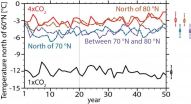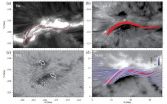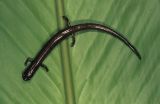The team, which includes LSU hydrogeologist Peter Doran and researchers from the University of Tennessee; University of California-Santa Cruz; Dartmouth College; University of Illinois at Chicago; University of Wisconsin; Aarhus University in Denmark; and Sorbonne Universités, UPMC University in France, found that brines, or salty water, form extensive aquifers below glaciers, lakes and within permanently frozen soils. Their discovery will be featured in the April 28 edition of the open-access journal Nature Communications.
"These unfrozen materials appear to be relics of past surface ecosystems, and our findings provide compelling evidence that they now provide deep subsurface habitats for microbial life despite extreme environmental conditions," said the study's lead author Jill Mikucki, an assistant professor of microbiology at the University of Tennessee Knoxville. "We believe the application of novel below-ground visualization technologies can not only reveal hidden microbial habitats, but can also provide insight on glacial dynamics and how Antarctica responds to climate change."
In addition to providing answers about the biological adaptations of previously unknown ecosystems that persist in the extreme cold and dark of the Antarctic winter, the new information could also help scientists understand whether similar conditions might exist elsewhere in the solar system, specifically beneath the surface of Mars, which has many similarities to the dry valleys.
"Over billions of years of evolution, microbes seem to have adapted to conditions in almost all surface and near-surface environments on Earth. Tiny pore spaces filled with hyper-saline brine staying liquid down to -15 Celsius, or 5 degrees Fahrenheit, may pose one of the greatest challenges to microbes," said Slawek Tulacyzk, a glaciologist and coauthor at the University of California, Santa Cruz. "Our electromagnetic data indicates that margins of Antarctica may shelter a vast microbial habitat, in which limits of life are tested by difficult physical and chemical conditions."
The team also found evidence that brines flow towards the Antarctic coast from roughly 11 miles inland, eventually discharging into the Southern Ocean. It is possible that nutrients from microbial weathering in these deep brines are released, effecting near-shore biological productivity. However, the vast majority of Antarctica's coastal margins remain unexplored. This new survey highlights the importance of these sensitive interfaces.
The Division of Polar Programs in NSF's Geoscience's Directorate supported the AEM sensor project through a collaborative award to Mikucki, Tulacyzk and Ross Virginia, a biogeochemist at Dartmouth College. The division manages the U.S. Antarctic Program, through which it coordinates all U.S. scientific research on the Southernmost Continent and provides the logistical support to that research.
The researchers used a transient electromagnetic AEM sensor called SkyTEM, mounted to a helicopter, to produce extensive imagery of the subsurface of the coldest, driest desert on our planet, the McMurdo Dry Valleys. Using a helicopter to make the observations allowed large areas of rugged terrain to be efficiently surveyed.
The results shed new light on the history and evolution of the dry valley landscape, which, uniquely in the Antarctic is ice-free and which during the height of the southern summer has free-flowing rivers and streams. The dry valleys are also home to briny lakes at the surface and beneath at least one of the glaciers that intrude into the Valleys.
"Prior to this discovery, we considered the lakes to all be isolated from one another and the ocean, but this new data suggests that there is a connection between the lakes and the ocean, which is very interesting and potentially a game changer in how we view the geochemistry and history of the lakes," said Doran, LSU professor of geology & geophysics and John Franks Endowed Chair.
Doran, the first to hold the John Franks Endowed Chair in geology & geophysics, is a natural fit for this research team in that the ground water system examined in this study is closely associated with the perennially ice covered lakes in the region that he has been studying for more than 20 years.
Doran joined the research team after the data was collected and assisted with the data interpretation.
"The first phase of this research was a proof of concept study and we definitely proved the concept," he said, adding that the team is in the process of writing a new proposal to NSF to continue their work.
Overall, the dry valleys ecosystem -- cold, vegetation-free and home only to microscopic animal and plant life -- resembles, during the Antarctic summer, conditions on the surface on Mars.
In addition to many other studies, the dry valleys are home to projects that are investigating how climate has changed over geologic time.
"This project is studying the past and present climate to, in part, understand how climate change in the future will affect biodiversity and ecosystem processes," said Virginia. "This fantastic new view beneath the surface will help us sort out competing ideas and theories about how the dry valleys have changed with time and how this history influences what we see today."
The AEM sensor, which was developed at Aarhus University in Denmark, was flown over the Taylor Glacier, one of the best-studied glaciers in the world, in November 2011. The glacier has a unique feature known as Blood Falls, where iron-rich brine from the subsurface is released at the front of the glacier. Blood Falls is known to harbor an active microbial community, where organisms use iron and sulfur compounds for energy and growth and in the process facilitate rock weathering.
The AEM team believes that the newly discovered brines harbor similar microbial communities persisting in the deep, cold dark aquifers. AEM instrumentation lead Esben Auken has flown the sensor all over the world, but this was the first time they tackled Antarctica.
"Antarctica is by far the most challenging place we have been." Auken said. "It was all worth it when we saw the raw data as it was offloaded from the helicopter. It clearly showed we were on to some extraordinary results, which no one had been able to produce before. We were excited because we knew this would change the way scientists in the future would view the hydrological cycle in the dry valleys. For us, the project was the result of many years of developing the best mapping technology in the world, and now we were able to collaborate with scientists who had worked in the Antarctic environment for decades and were willing to take the risk of letting us prove this could be done with success."
INFORMATION:
Related Links:
Washington Post Article: http://www.washingtonpost.com/news/speaking-of-science/wp/2015/04/28/the-dry-valleys-of-antarctica-may-actually-have-subsurface-water-full-of-life/
National Science Foundation: http://www.youtube.com/watch?v=5plXAKlpDkQ&feature=youtu.be



